“You have written the book Ålevangeliet – the story of the world’s most enigmatic fish, which has now been sold to 33 countries and recently won you the August Prize in the category for best Swedish non-fiction book. The book is about eels of course, but also about your relationship with your father – what do you think he would have said about you having just won a prestigious prize for a book that is partly about him?”
He would have been very surprised. He could probably not have imagined that anyone would be interested in reading a story about him, or that it would have even been written. This was also a part of his class identity. The natural ease with which certain people share their story and believe that it’s relevant and interesting to others – that doesn’t apply very often to working-class men born in the 1940s.
“You work on the editorial team for the culture sections of the newspapers Sydsvenskan and Helsingborgs Dagblad and this is your first book. How long did you carry the book around in your head before getting it down on paper?”
Perhaps in an unconscious form ever since I went fishing for eels with my father during my childhood and he told me about the mysterious Sargasso Sea and the eel’s metamorphoses and all the enigmas that still surround it. But more specifically since August 2017, when, for the first time, I sat down and started writing with what was still a rather vague idea of what I actually wanted to do.
“It’s clear that the eel is the world’s most enigmatic fish, but if you had to select the most fascinating characteristic or fact about the eel, which one would you choose?”
One fascinating thing is that time itself appears to be almost relative for the eel. When it goes through its last metamorphosis and becomes a silver eel it is evidently in the last stage of life, its old age you could say. Once it has swum back to the Sargasso Sea and bred, it dies. However, when the age of silver eels on the way to the Sargasso Sea was determined, it was shown that some were under ten years old, whereas others were close to 60. If an eel is prevented from heading to the Sargasso Sea, it does not go through its final metamorphosis and become a silver eel. It’s as if it can put life on hold; delay its own aging in some sense.
“It’s Christmas soon and your book is high on many people’s wish lists this year, but which book is on your wish list?”
I think it will probably be some of the August Prize-nominated books that I haven’t had time to read yet. Marit Kapla’s “Osebol” and Steve Sem-Sandberg’s “W”.

